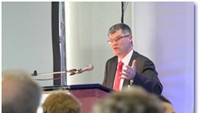European Commission tries to calm broadcasters over DTT future

European broadcasters were only half reassured when the European Commission’s head of radio spectrum policy Pearse O’Donohue told them last week that terrestrial transmission would not be ditched without provision for free public service TV.
O’Donohue was addressing the EBU Technical Assembly in Zagreb, supposedly to comfort broadcasters who have been concerned over the future of digital terrestrial TV transmission in Europe ever since a surprise decision at the World Radio Spectrum (WRC) 12 conference in Feb. 2012 to hand over a slice of the 700MHz spectrum band to mobile services after 2015. The EBU has strongly lobbied against these plans, arguing that there is a public interest in retaining plenty of spectrum space for future digital television services, but the European Commission has been more equivocal.
O’Donohue continued to tread the middle ground between broadcasters and mobile operators at the EBU conference last week when he said, “terrestrial television broadcasting would only be superceded by a wireless broadband system if an equally efficient and free media delivery means were available to the citizen.”
These words are somewhat ambiguous, for they could imply that free services will be provided by some other medium such as satellite or wireless Internet, or even over the mobile services that have stolen digital terrestrial’s spectrum.
O'Donohue went on to spell out the four options on the table for the 700MHz band once used entirely for terrestrial services, which are: to use it all for broadcasting; use it all for broadband; share the spectrum between broadcasting and broadband; or develop a “converged” system that does both. The next stage was, O’Donohue added, to discuss these four options with the whole industry — including the EBU. Broadcasters then winced slightly when O'Donohue went on to suggest that they should remember that “sticking your head in the sand is not a good strategy.”
At least though there are options on the table, which looked uncertain during the WRC-12 conference itself. The surprise move at WRC-12 was a call from Arab and African countries for a mobile allocation in the 700MHz range as an extended digital dividend. This was unexpected because this proposal was not on the original agenda, and it was a concern for Europe because the continent is part of the same spectrum Region 1 as the African and Middle Eastern countries concerned. Region 1 comprises the whole of Europe plus the part of Russia in Asia, all of Africa, and the Middle East west of the Persian Gulf. It shares some borders with, and therefore often has, the same allocations as Region 3, comprising the rest of Asia along with Australasia. The other Region 2 is all the Americas, sharing no terrestrial borders with the rest.
The African/Middle Eastern proposal was initially strongly opposed by both the EBU, and the European Conference of Postal and Telecommunications Administrations (CEPT), which is the coordinating body for European state telecommunications and postal organizations. It argued that this re-allocation would cause considerable problems in Europe, where the 700MHz band is widely used for terrestrial broadcasting, often with long-term licensing arrangements in place.
The professional video industry's #1 source for news, trends and product and tech information. Sign up below.
The EBU and CEPT also contended such a reallocation was too hasty, and that there should be time allowed for a careful review of spectrum in the light of advances in technology as well as changing cultural and political objectives, before committing to an approach that would dictate the fate of both mobile and terrestrial services for years to come. The argument here is that through emerging strategies for sharing spectrum and utilizing it more efficiently, it will be possible to meet the conflicting needs of all countries in the region.
But, the African and Middle Eastern countries were determined to get this reallocation through. This was because, unlike Europe, these countries have not deployed terrestrial TV services significantly, and want to devote as much spectrum as possible to mobile telephony, which will also deliver TV services in some cases. Cellular deployments are, in some cases, more advanced than in Europe, and many countries want to devote as much spectrum as possible to these, with little interest in digital terrestrial.
CEPT, and to an extent the EBU, accepted the importance of these proposals for the countries concerned, and therefore softened their opposition, reaching out for compromise during the later stages of the WRC-12 conference. The compromise finally achieved after long discussions did include allocation of the band 694MHz-790MHz to the mobile service, but only after the next global radio spectrum conference in three years time, WRC-15. There was also agreement to refine the lower edge of the allocation (694MHz), and define technical and regulatory conditions applicable to the mobile service in this band, both to be done at WRC-15.
At the time, Eric Fournier, chairman of CEPT’s Electronic Communications Committee Conference Preparatory Group, stated this compromise does take account of the need for European countries to study the issue better before taking a final position on the best suitable allocation and associated regulation. It also, Fournier added, paid due attention to the merits of harmonization, while at the same time fully preserves the possibility for each country and for CEPT to decide about the best use of this band after 2015.
This at least bought European terrestrial broadcasters some time, and scope for the discussions which are now set to take place. But the position spelt out by O’Donohue last week did little to dispel the fear among broadcasters that there is an emerging consensus 4G mobile services are going to be more valuable, and provide on balance greater societal benefits than digital terrestrial.
